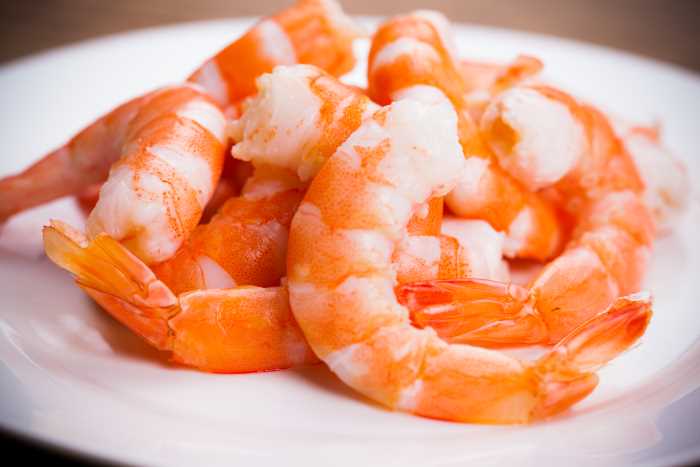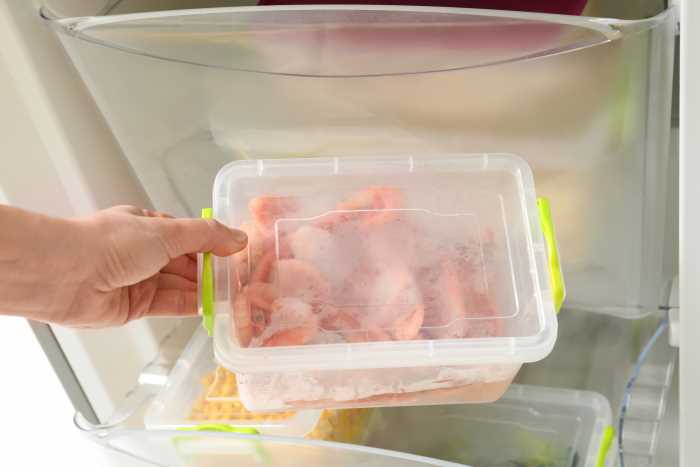As mouth-watering as shrimp look to you, they also make an inviting snack for many kinds of toxic bacteria. Even when cooked, shrimp can be an edgy cocktail of delicious and dangerous.
If you want to avoid terrible stomach trauma or worse, it’s important to ask, “Exactly how long is cooked shrimp is good for?”

Based on USDA recommendations, we estimate that cooked shrimp will remain safe on the table for only about two hours and in the fridge for about four days.
Here are some important safety tips for storing leftover cooked shrimp.
How Long Does Cooked Shrimp Last?
Just like most kinds of seafood, shrimp needs to be cooked and stored properly to avoid serious illness. Larger shrimp will keep longer than small shrimp, but not by much.
Cooked shrimp lasts about:
- 1 hour in summer temperatures
- 2 hours at room temperature
- 3-4 days in the fridge
- 3 months in the freezer
When in a room, do the safe thing. Refrigerate cooked shrimp within two hours. Bacteria love shellfish, and it takes less than three hours for shrimp to reach toxic levels at temperatures between 40°F and 90°F.
If it’s summertime, your air con is broken, and the dining room is over 90 degrees, shrimp shelf life will be halved. Only leave out what you know you can eat during that meal, and put the rest of the shrimp in the fridge within an hour of cooking them.

You can keep cooked shrimp a bit longer by storing them properly in the fridge.
Temperatures under 40 degrees will slow bacterial growth to a crawl but won’t stop it completely. Even in the fridge, it will only take three or four days for the inevitable bacterial takeover to reach problematic levels.
If you need to keep your shrimp for longer than four days, you can freeze it. Freezing shrimp will stop the bacterial growth, but it will also change the shrimp’s texture and taste in subtle and not-so-subtle ways.
While you should technically be able to store your shrimp for years at below-freezing temperatures, we recommend eating them within three months at most. Even in an airtight container, frozen shrimp loses most of its deliciousness after about a trimester.
How Long Does Shrimp Last?
Unless you get your shrimp straight off the boat, it’s next to impossible to know for sure whether your shrimp is at peak freshness or not.
If you buy shrimp at the grocery store, it’s probably been through an arduous cross-country journey to get there. It may already be a couple of days to a week old.
If you live inland, your shrimp may have been frozen and defrosted at least once.
Temperature changes are a great way to jumpstart bacterial growth, so you’re most likely on a ticking clock. Freezing and defrosting shrimp can also start to break down its proteins and accelerate its loss of nutrients and taste.
Shrimp sellers often dip their batches in a bleach solution to try to kill rioting bacteria. This can buy some time, but shrimp is particularly susceptible to foodborne pathogens, and it won’t take long for bacterial colonies to start multiplying again.
Whether shelled or unshelled, fresh shrimp needs to be refrigerated. It will stay delicious for a couple of days, but shrimp can become dangerous fast. We don’t recommend refrigerating fresh shrimp for more than two or three days.
How To Tell if Shrimp Is Bad
Eating bad shrimp can cause serious health problems. If you regularly eat shrimp, knowing how to identify signs of trouble could save your stomach or even your life.
Keep your senses open for these bad shrimp omens:
- Dullness, discoloration or dark spots
- Strong fishy or bleachy odor
- Sticky, slimy or loose texture
Start with the shrimp’s appearance. Cooked shrimp should be vivid pink or red. If their colors have dulled considerably, your shrimp are getting too old. If they’ve turned brown, don’t risk eating them.
Unless you specifically bought striped or spotted shrimp, dark rings or spots probably point to spoiled shrimp.
Next, check the smell. Good shrimp may smell vaguely of salty sea. Bad shrimp can either develop a sour fishy smell or a pungent odor similar to ammonia. If it smells strongly of anything at all, we recommend exercising extreme caution.
Last, let’s do a touch test. If the shrimp stick to your fingers, you might want to skip them. If you feel slime, they’re past their prime.
Fresh shrimp show some of the same danger signs when they go bad as well as a few different ones.
- Fresh shrimp meat should be firm and firmly attached to its shell.
- Black spots on fresh shrimp shells indicate that the flesh inside has probably begun to decompose.
- Yellow grit on the shells can mean that someone has tried to disguise the shrimp’s age with sodium bisulfate.
- Dried or shrunken eyes can point to aging shrimp. The shinier the eyes are, the more recently the shrimp have been caught.
You can throw bad shrimp in the trash or use it as fertilizer if you have a garden. Shrimp are full of nutrients that plants love. Shellfish bacteria that can knock humans for a loop won’t hurt plants.
You can bury spoiled shrimp in your backyard and grow something wonderful on top to keep the circle of life going strong.
What Happens If You Eat Bad Shrimp?
As delicious as shrimp looks to you, it’s even more appetizing to illness-bearing pathogens. Food poisoning from contaminated shrimp is a risk that shouldn’t be taken lightly.
You may develop symptoms right away, but it could take as long as 48 hours before you start to feel terrible. Initial symptoms may include:
- Stomach cramps
- Nausea and vomiting
- Diarrhea
The most immediate danger from shellfish poisoning is dehydration. If you or someone you love develops symptoms, make sure to keep plenty of water or other clear fluids on hand.
If you can’t keep any fluids down for more than 24 hours, feel feverish or see blood in your stool, we recommend going to a hospital immediately.
How To Store Shrimp
To avoid getting sick from contaminated shrimp:
- Refrigerate within two hours of cooking
- Keep air out
- Consume within four days of refrigerating
If you’re serving shrimp and you have to let them sit out for longer than a couple of hours, we recommend putting them on ice. Ice can put the bacteria on hold for a bit longer in a pinch, and cooked shrimp still tastes great cold.
Don’t put shrimp in the fridge warm. Two hours should be plenty to let them cool down to room temperature. Once they hit room temperature, either put them on ice, or refrigerate them as soon as possible.
Keep your shrimp in an airtight container in the fridge. If you don’t have a sealed container, you can wrap them in aluminum foil. We prefer a container because it does a better job of keeping the shrimp flavor separate from the other foods in your fridge.
Even if you keep your shrimp in an airtight container in the fridge, bacteria may find a way in. It’s safest to finish them within four days at most.
Final Thoughts
Eating old shrimp is a potentially life-threatening risk. If it’s been sitting out for over two hours or in the fridge for more than four days, eating it could give you food poisoning and keep you bedridden for days.
If your shrimp is discolored, smelly, sticky or slimy, throw it out or use it in your garden as fertilizer.











